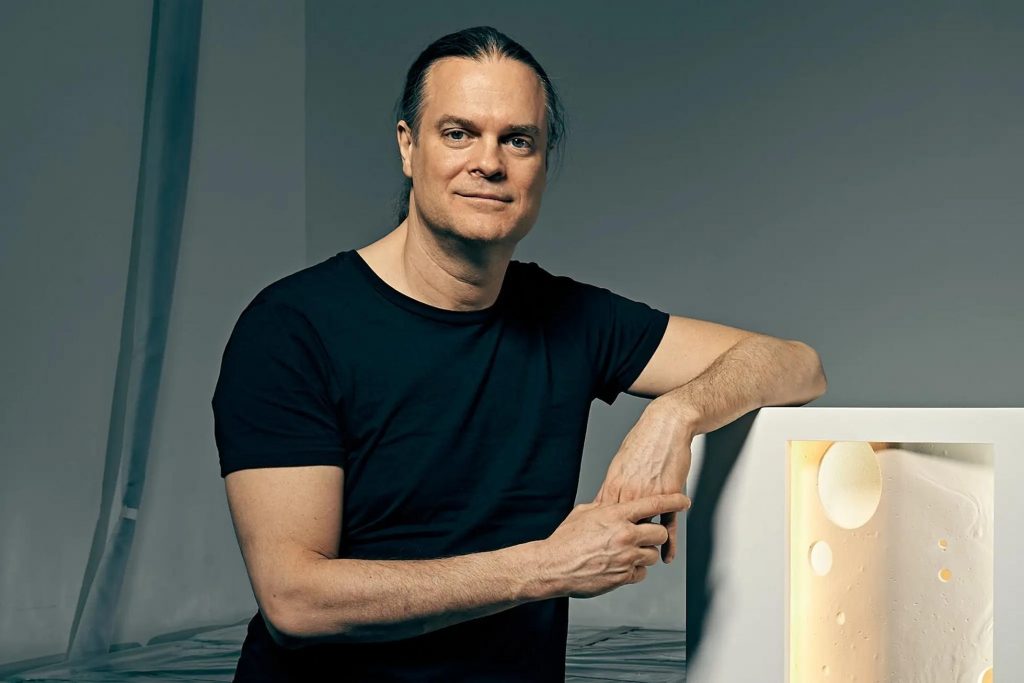Bentley Meeker is an artist and lighting designer based in New York City, known for his work lighting shows and events for celebrities like Paul McCartney, Rihanna, Jay-Z, Madonna and Mariah Carey, and has lit runway shows for Ralph Lauren, Moncler, Carolina Herrera and Alexander Wang.
Now, he recently opened a solo exhibition, “Veluminosity,” at Charles Saffati and Claude Pardo’s Carlton Fine Arts on Madison Avenue on November 5 in New York City. The show looks at the two-color temperatures we see and know and see every day; mainly due to our halo, LED or ring lights for selfies, social media videos and Zoom meetings. He pits these two contrasting light temperatures: 3,200-degree Kelvin “film white” (a warmer, more amber hue) and 5,600-degree Kelvin “daylight white” (a cooler, bluer white).
We either present ourselves, at least lit, on one of the two hues, it has become the dual light spectrum of our online era. It’s the color warmth scale of our smartphones. The contrast is how light can shape our emotional experience, but we don’t really realize how much of a contrast they have, until pitted against each other; it’s like winter versus summer.
“Basically, it’s the juxtaposition of colored temperature,” said Meeker, who is the president and founder of Bentley Meeker Lighting and Staging, and has exhibited at the Whitney Museum of Art, the Southampton Center for the Arts, the National Arts Club, the CORE Club, among others.
“So, the surfaces were created to make the light look interesting and catch your eye visually. But really, the thesis here are light temperature differentials.”
He explains: “Daylight, white versus film white, and then if you look at it, daylight white versus film white. So, the idea is just looking at the different color temperatures.”
Influencers and content creators depend on LED selfie lights, which a lot of people use either with cold blue light or warm sunlight hue. Both are trademarks of our time.
“I started playing around with materials, surfaces and textures and it turned into an exploration into the colors of our everyday digital lives in a subtle way,” he adds.
Lighting is everything when it comes to vanity. We live in a time when celebrities will turn down an onscreen interview if the lighting isn’t right.
“Simply put, light around us is all gradations of color and we are not aware of that,” said Meeker. “By putting colors together, ones that are so commonly seen they are basically unseen, in a juxtaposed setting, my hope is to create new awareness that is then available to the viewer.”
Meeker has built his career doing lighting design for high profile clients, from Melissa Rivers’ wedding at the Plaza Hotel, to White House dinners, to doing lighting design for 50 Cent, Adele, Cartier, Martha Stewart and Naomi Campbell over his 30-year career.
“Lighting design for events is one of the most fundamental elements for comfort or discomfort,” said Meeker. “Bright lights bring discomfort. But soft, elegant colors, symmetry or deliberate asymmetry are important hallmarks of good lighting design, and all of it contributes to a positive guest experience; and guest experience is everything in events.”
Some of his visual trademarks include gradient colors blending into one another, halogen lights, small bulbs on wires and the use of shadows to create compositions. His work includes creating large-scale installations at the Burning Man music festival Black Rock Desert of Nevada, where he has created dramatic temples several years in a row.
“Participating in Burning Man taught me the power of trusting my vision as an artist,” said Meeker. “Doing things in such difficult and adverse conditions as Burning Man teaches you to believe in yourself in ways that you otherwise wouldn’t. I’m grateful for those lessons.”
When it comes to fashion, he has collaborated with YSL, Alexander Wang, Calvin Klein, Karl Lagerfeld and Christian Dior for runway shows and events. Runway lighting design is evolving. “I think showing lines on a runway is an irreplaceable way of displaying new designs,” he said.
Quality lighting always must be geared towards capturing quality video. “No lighting means no video. No video means no marketing,” he said. “If lighting is everything, in fashion, other than the designer and clothing, it truly is everything.”
Another trend with lighting design for fashion presentations and runway shows is special, colored lighting, as well as symmetrical lighting. At the recent Paris Fashion Week, there were strobe lights (Vetements show), soft colorful lighting (Vivienne Westwood) and warm hued lighting (Thom Browne show).
“We can change colors and add strobe lights, but the protein and vegetables of a fashion show are most importantly a good-looking video and, by extension, almost always a clean, white sheet of light that showcases the lines,” said Meeker. “Lighting is special, but in fashion, it should complement the collection, first and foremost.”
He worked with The Weeknd for the Museum of Modern Art’s Party in the Garden 2015. “His team insisted on no front light, which was absurd to me; I legitimately thought they were making a profound mistake, borne out of what I arrogantly thought was inexperience,” said Meeker.
“So, I put front light up anyway and was ready to turn it on – again, considering the guest’s experience – at a moment notice. But the way they silhouetted his dreads (at the time he had them thrusting forward on his head), and the look they created was so cool and unexpected, to me, that we never turned the front lights on and the show looked incredible. I learned something that day.”
Next up, Meeker wants to dig into the science of good lighting. He describes it as “seeing what the refractive qualities of individual frequencies of light are.” He first touched on this topic with lasers and crushed plastic water bottles in his piece “Spring 2012” at the Southampton Arts Center opening exhibition. “Taking a laser of a single light frequency, refracting it and displaying that is what I will be doing next.”

